Jennifer Sleeman
Difference Learning for Air Quality Forecasting Transport Emulation
Feb 22, 2024



Abstract:Human health is negatively impacted by poor air quality including increased risk for respiratory and cardiovascular disease. Due to a recent increase in extreme air quality events, both globally and locally in the United States, finer resolution air quality forecasting guidance is needed to effectively adapt to these events. The National Oceanic and Atmospheric Administration provides air quality forecasting guidance for the Continental United States. Their air quality forecasting model is based on a 15 km spatial resolution; however, the goal is to reach a three km spatial resolution. This is currently not feasible due in part to prohibitive computational requirements for modeling the transport of chemical species. In this work, we describe a deep learning transport emulator that is able to reduce computations while maintaining skill comparable with the existing numerical model. We show how this method maintains skill in the presence of extreme air quality events, making it a potential candidate for operational use. We also explore evaluating how well this model maintains the physical properties of the modeled transport for a given set of species.
Neuro-Symbolic Bi-Directional Translation -- Deep Learning Explainability for Climate Tipping Point Research
Jun 19, 2023Abstract:In recent years, there has been an increase in using deep learning for climate and weather modeling. Though results have been impressive, explainability and interpretability of deep learning models are still a challenge. A third wave of Artificial Intelligence (AI), which includes logic and reasoning, has been described as a way to address these issues. Neuro-symbolic AI is a key component of this integration of logic and reasoning with deep learning. In this work we propose a neuro-symbolic approach called Neuro-Symbolic Question-Answer Program Translator, or NS-QAPT, to address explainability and interpretability for deep learning climate simulation, applied to climate tipping point discovery. The NS-QAPT method includes a bidirectional encoder-decoder architecture that translates between domain-specific questions and executable programs used to direct the climate simulation, acting as a bridge between climate scientists and deep learning models. We show early compelling results of this translation method and introduce a domain-specific language and associated executable programs for a commonly known tipping point, the collapse of the Atlantic Meridional Overturning Circulation (AMOC).
Forecast-Aware Model Driven LSTM
Mar 23, 2023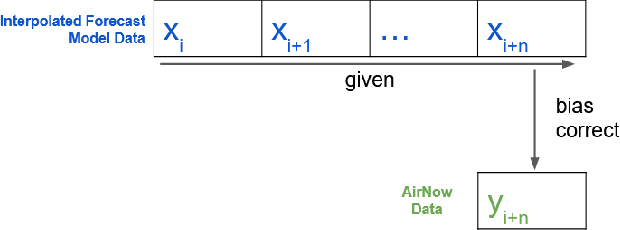

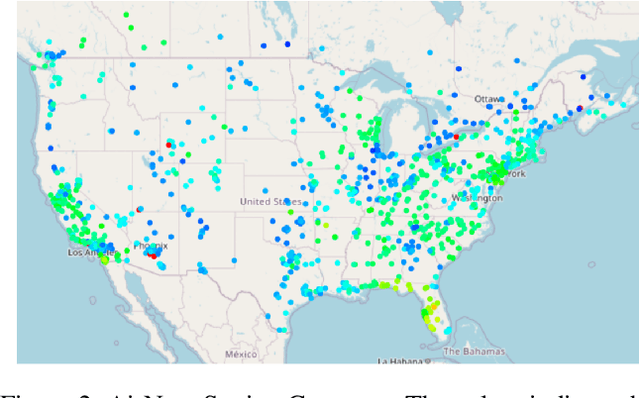

Abstract:Poor air quality can have a significant impact on human health. The National Oceanic and Atmospheric Administration (NOAA) air quality forecasting guidance is challenged by the increasing presence of extreme air quality events due to extreme weather events such as wild fires and heatwaves. These extreme air quality events further affect human health. Traditional methods used to correct model bias make assumptions about linearity and the underlying distribution. Extreme air quality events tend to occur without a strong signal leading up to the event and this behavior tends to cause existing methods to either under or over compensate for the bias. Deep learning holds promise for air quality forecasting in the presence of extreme air quality events due to its ability to generalize and learn nonlinear problems. However, in the presence of these anomalous air quality events, standard deep network approaches that use a single network for generalizing to future forecasts, may not always provide the best performance even with a full feature-set including geography and meteorology. In this work we describe a method that combines unsupervised learning and a forecast-aware bi-directional LSTM network to perform bias correction for operational air quality forecasting using AirNow station data for ozone and PM2.5 in the continental US. Using an unsupervised clustering method trained on station geographical features such as latitude and longitude, urbanization, and elevation, the learned clusters direct training by partitioning the training data for the LSTM networks. LSTMs are forecast-aware and implemented using a unique way to perform learning forward and backwards in time across forecasting days. When comparing the RMSE of the forecast model to the RMSE of the bias corrected model, the bias corrected model shows significant improvement (27\% lower RMSE for ozone) over the base forecast.
A Generative Adversarial Network for Climate Tipping Point Discovery (TIP-GAN)
Feb 16, 2023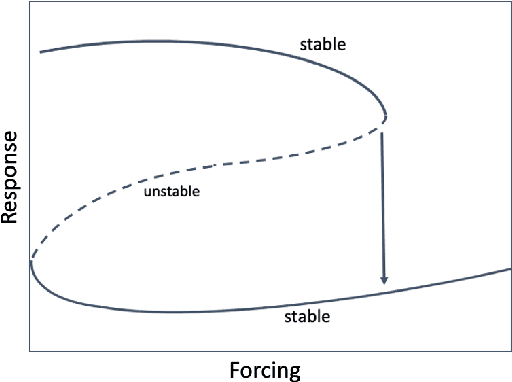

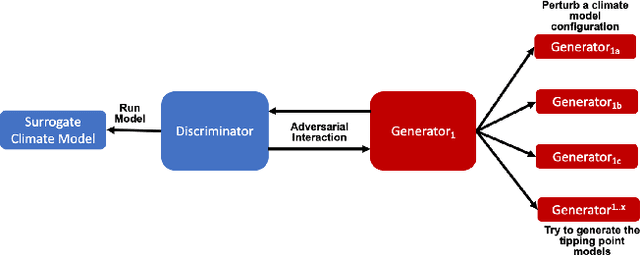

Abstract:We propose a new Tipping Point Generative Adversarial Network (TIP-GAN) for better characterizing potential climate tipping points in Earth system models. We describe an adversarial game to explore the parameter space of these models, detect upcoming tipping points, and discover the drivers of tipping points. In this setup, a set of generators learn to construct model configurations that will invoke a climate tipping point. The discriminator learns to identify which generators are generating each model configuration and whether a given configuration will lead to a tipping point. The discriminator is trained using an oracle (a surrogate climate model) to test if a generated model configuration leads to a tipping point or not. We demonstrate the application of this GAN to invoke the collapse of the Atlantic Meridional Overturning Circulation (AMOC). We share experimental results of modifying the loss functions and the number of generators to exploit the area of uncertainty in model state space near a climate tipping point. In addition, we show that our trained discriminator can predict AMOC collapse with a high degree of accuracy without the use of the oracle. This approach could generalize to other tipping points, and could augment climate modeling research by directing users interested in studying tipping points to parameter sets likely to induce said tipping points in their computationally intensive climate models.
Using Artificial Intelligence to aid Scientific Discovery of Climate Tipping Points
Feb 14, 2023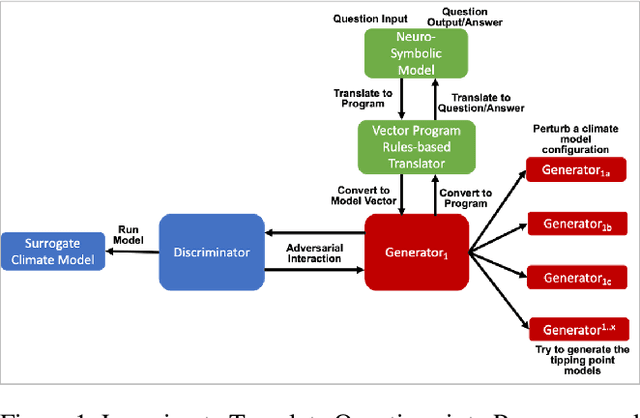

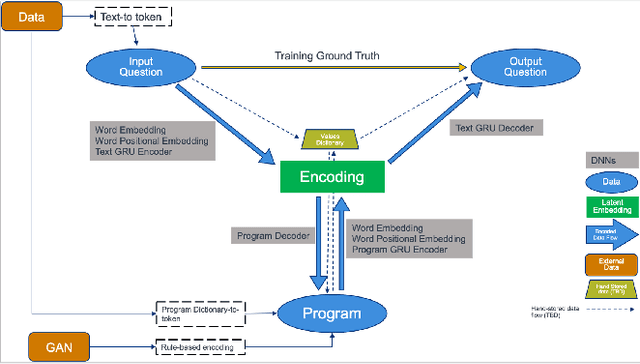

Abstract:We propose a hybrid Artificial Intelligence (AI) climate modeling approach that enables climate modelers in scientific discovery using a climate-targeted simulation methodology based on a novel combination of deep neural networks and mathematical methods for modeling dynamical systems. The simulations are grounded by a neuro-symbolic language that both enables question answering of what is learned by the AI methods and provides a means of explainability. We describe how this methodology can be applied to the discovery of climate tipping points and, in particular, the collapse of the Atlantic Meridional Overturning Circulation (AMOC). We show how this methodology is able to predict AMOC collapse with a high degree of accuracy using a surrogate climate model for ocean interaction. We also show preliminary results of neuro-symbolic method performance when translating between natural language questions and symbolically learned representations. Our AI methodology shows promising early results, potentially enabling faster climate tipping point related research that would otherwise be computationally infeasible.
A Hybrid Quantum enabled RBM Advantage: Convolutional Autoencoders For Quantum Image Compression and Generative Learning
Jan 31, 2020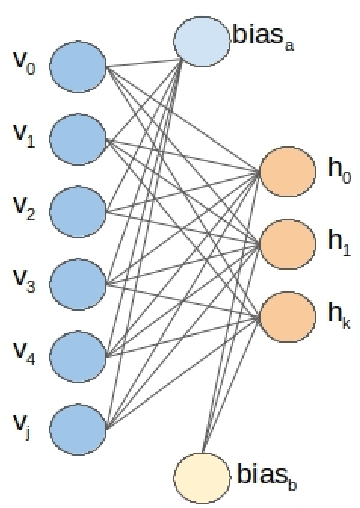

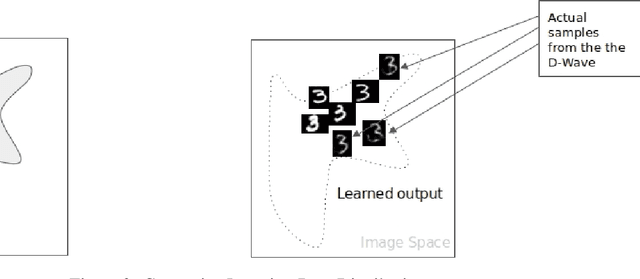

Abstract:Understanding how the D-Wave quantum computer could be used for machine learning problems is of growing interest. Our work evaluates the feasibility of using the D-Wave as a sampler for machine learning. We describe a hybrid system that combines a classical deep neural network autoencoder with a quantum annealing Restricted Boltzmann Machine (RBM) using the D-Wave. We evaluate our hybrid autoencoder algorithm using two datasets, the MNIST dataset and MNIST Fashion dataset. We evaluate the quality of this method by using a downstream classification method where the training is based on quantum RBM-generated samples. Our method overcomes two key limitations in the current 2000-qubit D-Wave processor, namely the limited number of qubits available to accommodate typical problem sizes for fully connected quantum objective functions and samples that are binary pixel representations. As a consequence of these limitations we are able to show how we achieved nearly a 22-fold compression factor of grayscale 28 x 28 sized images to binary 6 x 6 sized images with a lossy recovery of the original 28 x 28 grayscale images. We further show how generating samples from the D-Wave after training the RBM, resulted in 28 x 28 images that were variations of the original input data distribution, as opposed to recreating the training samples. We formulated an MNIST classification problem using a deep convolutional neural network that used samples from a quantum RBM to train the MNIST classifier and compared the results with an MNIST classifier trained with the original MNIST training data set, as well as an MNIST classifier trained using classical RBM samples. Our hybrid autoencoder approach indicates advantage for RBM results relative to the use of a current RBM classical computer implementation for image-based machine learning and even more promising results for the next generation D-Wave quantum system.
Ontology-Grounded Topic Modeling for Climate Science Research
Jul 31, 2018



Abstract:In scientific disciplines where research findings have a strong impact on society, reducing the amount of time it takes to understand, synthesize and exploit the research is invaluable. Topic modeling is an effective technique for summarizing a collection of documents to find the main themes among them and to classify other documents that have a similar mixture of co-occurring words. We show how grounding a topic model with an ontology, extracted from a glossary of important domain phrases, improves the topics generated and makes them easier to understand. We apply and evaluate this method to the climate science domain. The result improves the topics generated and supports faster research understanding, discovery of social networks among researchers, and automatic ontology generation.
 Add to Chrome
Add to Chrome Add to Firefox
Add to Firefox Add to Edge
Add to Edge